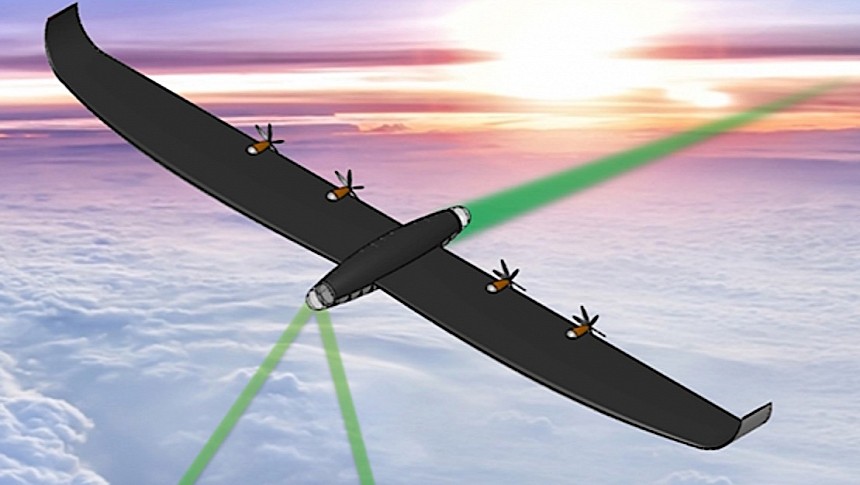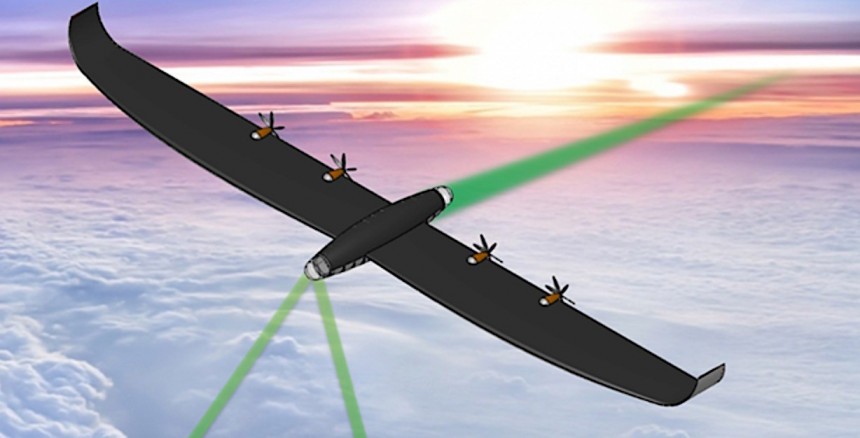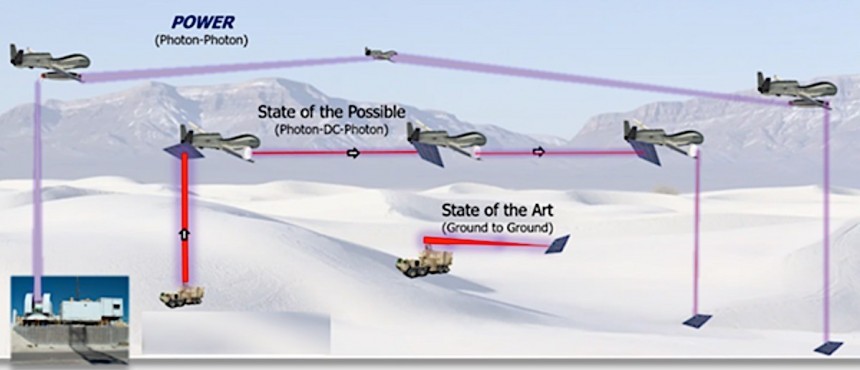Time and again modern wars have proven you can't really fight battles without having access to energy. Whereas until the advent of the last century all armies had to worry about was food, shelter, and ammo for their soldiers, advancements in technology brought with them a dire need for fuel and, more recently, even electricity and an Internet connection.
Advanced as we like to believe our armies to be, they mostly still need a direct resupply line, be it on the ground or via aircraft, and they also need access to energy. On today's battlefields, as always, such direct lines are not always possible to establish and maintain. That's why alternative resupply options are currently being researched.
When it comes to energy, one such alternative option is something called POWER. That's short for Persistent Optical Wireless Energy Relay, and it's a program established by DARPA with the goal of finding ways to directly beam energy to where it's needed from the air.
The program was announced more than a year ago, and its stated mission is to find ways to beam down power to gear and people in combat zones using a so-called "speed of light wireless energy web."
DARPA calls these ways of energy transmission airborne optical energy relays, and they are considered a critical component of a system that also comprises ground-based lasers. Placed in a web, these relays should form wireless energy networks to serve the needs of the military.
The way this process is supposed to work looks simple on paper, but may prove difficult to implement. Basically, a power source (in this case the ground-based lasers) generates power, and that power is transformed into an electromagnetic propagating wave.
A receiver located in the air catches the wave, and turns it back to electricity. It then sends it to where it's needed in the same way.
The working principle behind this tech may sound a bit far fetched, but according to DARPA it is not that different from the tech and methods we presently use in wireless communications. What's tricky to do though is nail the proper conversion efficiency, as transforming power into a wave and then back to electricity comes with "unacceptable losses."
"Each one of those conversions is relatively inefficient and multiplying them across a chain is impractical," the research agency says.
And that's where the POWER program comes in, as it will try to find the best solutions to the conversion efficiency problem. That means power-beaming relays to redirect optical energy transmissions through a high-quality beam.
When it announced the program DARPA said we're facing a three-phase program that will culminate in a flight demonstration. This week defense contractor Raytheon announced it received a $10 million contract from DARPA to do exactly that.
Over the next two years Raytheon will work at its facility in El Segundo, California, on an airborne relay system that could form the basis for these energy webs and will be capable of receiving and transmitting wireless energy.
If it works, such a system could become something DARPA likes to call (and for obvious reasons), the Internet for energy. For the military, such a system could prove invaluable, as it should not only solve the energy supply problem in contested environments but will also allow energy to get to where it's needed a lot faster than through the traditional infrastructure.
Why then, if this solution is so revolutionary, doesn't DARPA think of using it for more benign purposes? Well, it does think about it and, just like it happened with the Internet system you're using to read this right now, does not rule out civilian use.
In fact, airborne energy relays should make power cheap, readily available, and widespread, and that could serve the needs of "energy-starved consumers."
If you're thinking this POWER program is yet another DARPA program that will never come to fruition, think again. The agency sees the need to move away from established energy infrastructure and reliance on liquid fuels as stringent.
Doing that also means eliminating the need for some military gear to carry their own power supplies, and that in turn could lead to better and more effective designs of military platforms. At the same time, it drastically improves the range and endurance of things like drones, sensors, and effectors, operating anywhere in this world, in the air, on the ground, or even in the water.
As a final note, the POWER program is not a standalone idea someone over at DARPA had, and it's part of a larger plan called Energy Web Dominance. It's a wider effort meant to give American military commanders the capability to "reroute energy in a matter of seconds or minutes, enabling them to pivot capability near instantaneously without reconfiguring supply lines."
Aside from the two-year deadline announced by Raytheon, we have no timetable as to when to expect something tangible resulting from this program being deployed for actual use in a real-world application.
When it comes to energy, one such alternative option is something called POWER. That's short for Persistent Optical Wireless Energy Relay, and it's a program established by DARPA with the goal of finding ways to directly beam energy to where it's needed from the air.
The program was announced more than a year ago, and its stated mission is to find ways to beam down power to gear and people in combat zones using a so-called "speed of light wireless energy web."
DARPA calls these ways of energy transmission airborne optical energy relays, and they are considered a critical component of a system that also comprises ground-based lasers. Placed in a web, these relays should form wireless energy networks to serve the needs of the military.
The way this process is supposed to work looks simple on paper, but may prove difficult to implement. Basically, a power source (in this case the ground-based lasers) generates power, and that power is transformed into an electromagnetic propagating wave.
A receiver located in the air catches the wave, and turns it back to electricity. It then sends it to where it's needed in the same way.
"Each one of those conversions is relatively inefficient and multiplying them across a chain is impractical," the research agency says.
And that's where the POWER program comes in, as it will try to find the best solutions to the conversion efficiency problem. That means power-beaming relays to redirect optical energy transmissions through a high-quality beam.
When it announced the program DARPA said we're facing a three-phase program that will culminate in a flight demonstration. This week defense contractor Raytheon announced it received a $10 million contract from DARPA to do exactly that.
Over the next two years Raytheon will work at its facility in El Segundo, California, on an airborne relay system that could form the basis for these energy webs and will be capable of receiving and transmitting wireless energy.
If it works, such a system could become something DARPA likes to call (and for obvious reasons), the Internet for energy. For the military, such a system could prove invaluable, as it should not only solve the energy supply problem in contested environments but will also allow energy to get to where it's needed a lot faster than through the traditional infrastructure.
In fact, airborne energy relays should make power cheap, readily available, and widespread, and that could serve the needs of "energy-starved consumers."
If you're thinking this POWER program is yet another DARPA program that will never come to fruition, think again. The agency sees the need to move away from established energy infrastructure and reliance on liquid fuels as stringent.
Doing that also means eliminating the need for some military gear to carry their own power supplies, and that in turn could lead to better and more effective designs of military platforms. At the same time, it drastically improves the range and endurance of things like drones, sensors, and effectors, operating anywhere in this world, in the air, on the ground, or even in the water.
As a final note, the POWER program is not a standalone idea someone over at DARPA had, and it's part of a larger plan called Energy Web Dominance. It's a wider effort meant to give American military commanders the capability to "reroute energy in a matter of seconds or minutes, enabling them to pivot capability near instantaneously without reconfiguring supply lines."
Aside from the two-year deadline announced by Raytheon, we have no timetable as to when to expect something tangible resulting from this program being deployed for actual use in a real-world application.









